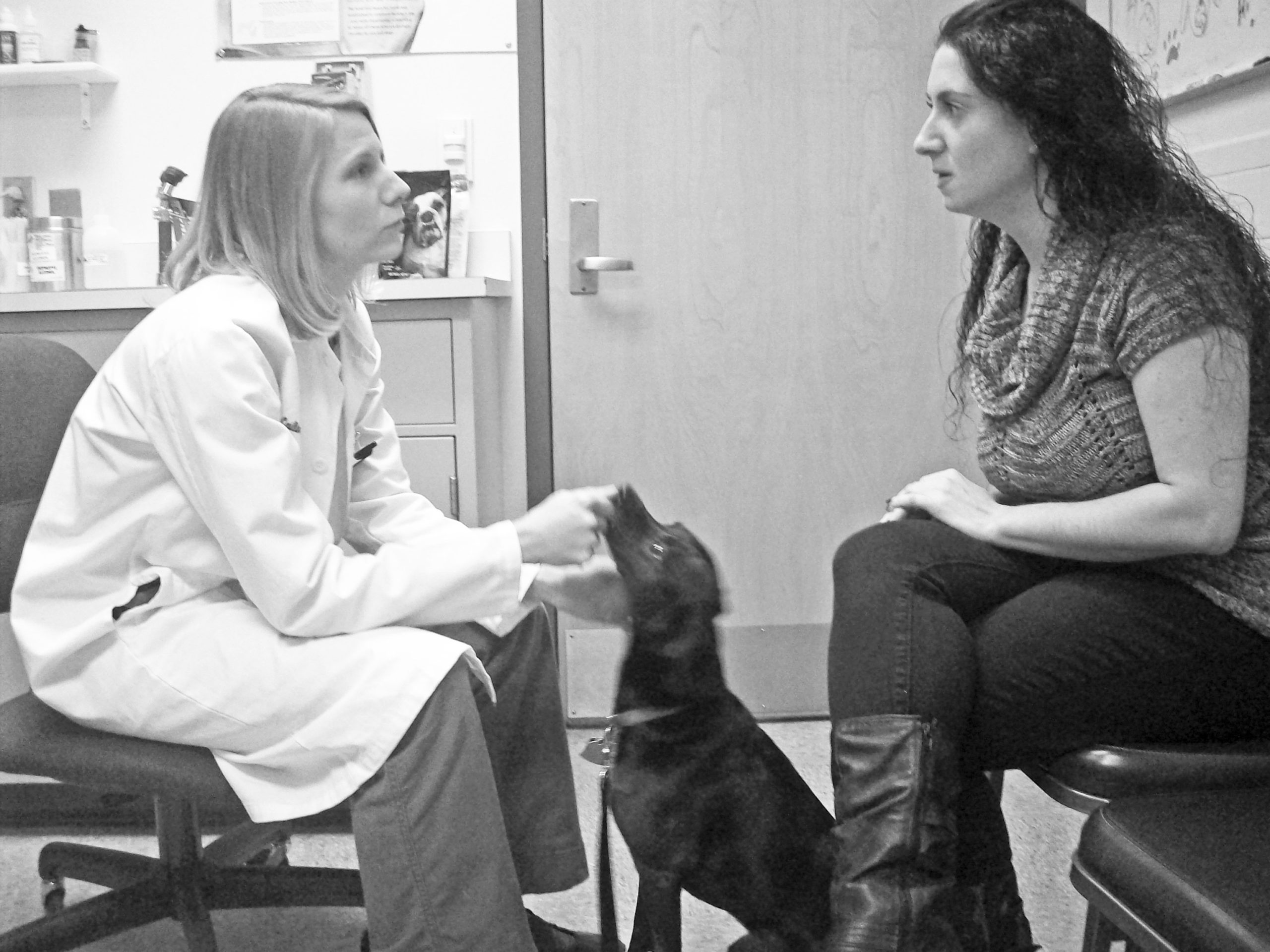“Many pet owners are resistant to feed the diets prescribed” to help manage a dog’s kidney disease, says Cailin Heinze, VMD, a board-certified veterinary nutritionist at Tufts. “They fear their pet won’t eat or won’t like the food, or they prefer to feed food from different manufacturers,” Dr. Heinze points out. “They may also feel put off by the expense. For the average owner, a therapeutic diet formulated to help manage a dog’s kidney disease is going to be more expensive.”
But what an owner may not realize, Dr. Heinze says, is that kidney disease is not a condition “where a therapeutic diet might help. It’s a disease for which we have data that diet is a critical part of treatment,” and these special diets must be prescribed by a veterinarian rather than bought over the counter.
How much will the dog benefit? One landmark study demonstrated that dogs with kidney disease fed a prescribed, therapeutic diet lived, on average, twice as long as their sick counterparts fed food similar to the kinds you could buy over the counter. Dogs that eat kidney diets also appear to feel less sick, with a better quality of life in the bargain.
“This is a disease where we don’t always have a lot of really good medical options, especially ones that have been shown to have such a dramatic potential to improve quality and quantity of life,” says Dr. Heinze. “Kidney disease appears to be particularly responsive to nutritional management. It’s certainly one of the most common reasons owners come to see us in the Clinical Nutrition Service at Tufts, if not the most common reason.”
Indeed, options for high-tech medical treatment of chronic kidney disease, particularly end-stage disease, are scant to nil. Procedures like long-term dialysis and kidney transplants are not available in most places and, even if they are, are prohibitively expensive for most pet owners. But symptomatic treatment — using diet to keep a dog as comfortable and as physiologically balanced as possible as her disease progresses — is a critical mainstay of care. A dog with chronic kidney failure can live much longer if her symptoms are treated properly.
Critical Components of a Kidney Diet for Dogs
There are two main types of kidney disease in dogs. The more common type affects the tubules, parts of the kidneys involved in making urine as well as removing waste products from the blood for urinary excretion.The other type involves damage to the glomerulus, a kind of sieve that lets waste products into the tubules to be removed from the body but is supposed to hold back critical substances the body needs, like protein.

With kidney disease that affects the tubules, waste products build up in the bloodstream rather than get excreted into the urine, and they become toxic to the body. One of those waste products is phosphorus. It’s an essential nutrient, but when there’s an excess because of compromised kidneys, it interacts with calcium, causing loss of calcium from bone and leading to mineral buildup in parts of the body that shouldn’t have any. The kidneys themselves can become mineralized, hastening the progression of the disease.
Over-the-counter diets only compound the problem, especially in advanced stages of kidney disease. They generally contain at least twice the amount of phosphorus a dog requires. “Some brands have four times the amount of phosphorus that a dog needs,” Dr. Heinze says. Therapeutic kidney diets, by contrast, contain levels of phosphorus that are much lower — as much as 65 percent lower than over-the-counter diets are required to contain. “Several good studies suggest that lowering phosphorus in the diet leads to slower progression of kidney disease,” Dr. Heinze relates.
It’s a similar story with protein. A lot of the waste that builds up in the bloodstream includes metabolites that come from the digestion of protein. The more protein you feed, the more the dog’s body has to break down, and the higher the level of waste products. If a dog has kidney disease, those waste products remain in the bloodstream. They don’t do further damage to the kidneys, as phosphorus can, but they can make a dog feel even sicker than she already does.
Over-the-counter foods have considerably more protein than a dog actually needs. Therapeutic diets for kidney disease, on the other hand, avoid excess protein while ensuring that protein needs are met. Moreover, the protein is very high quality, so it will more likely be incorporated into new proteins in the body rather than broken down into additional waste for the kidneys to process.
Prescribed therapeutic diets low in protein also benefit dogs with kidney disease that affects the glomerulus, known as protein-losing nephropathy. It sounds counterintuitive to give a dog with a “protein-losing” form of the disease a reduced-protein diet, and for that reason, a number of Internet sites recommend feeding more, not less, protein to dogs with this condition. But with this type of kidney disease, protein is even more of a problem than it is in cases of tubular disease. It further compromises the kidneys’ functioning rather than simply causing a dog to feel worse. The more protein a dog with protein-losing nephropathy eats, the more pressure there will be at the glomerulus to push the protein through the “holes” of the sieve, causing further kidney damage. Excessive protein is such a concern for a dog with kidney disease that affects the glomerulus that even if a dog with this condition has reasonably normal kidney function otherwise, Dr. Heinze may restrict her protein to the same degree that she restricts protein in a dog with moderate to severe tubular kidney disease.
“The other nutrients we look at” in a dog with kidney disease, says Dr. Heinze, are sodium and potassium. Generally, she says, “we want to see lower-sodium diets, because a lot of animals with kidney disease have some degree of high blood pressure. We know for certain that excess sodium is associated with increased blood pressure in people. It’s a little more foggy in dogs, but lowering their sodium intake seems an appropriate measure to take. The average pet food has four to 10 times the sodium that a dog actually needs. A therapeutic kidney diet will have much less.

“We worry about potassium, too,” she adds, because some dogs with kidney disease tend to have relatively high blood levels of that nutrient. Sometimes it depends on the medicines they’re taking, which can alter potassium levels.” Medications that elevate potassium are most often used in dogs with protein-losing nephropathy.
Other than lower levels of particular nutrients, some therapeutic foods prescribed for dogs with kidney disease contain added omega-3 fatty acids. “We generally recommend that dogs with kidney disease eat a diet containing omega-3s or take a supplement recommended by a veterinary nutritionist,” Dr. Heinze says. The omega-3s, particularly if they are from fish oil rather than flax, have been shown in some studies to have a bit of a protective effect on the kidneys.”
Finally, Dr. Heinze says, because the blood tends to become more acidic as the kidneys fail, the therapeutic diets prescribed are designed to be more alkalizing in order to help maintain the body’s delicate acid/base balance. Over-the-counter diets are not formulated with that concern in mind.
Dog owners should be aware that there are more than a dozen therapeutic diets available to manage kidney disease, each with somewhat different levels of key nutrients as well as different tastes and textures. Your veterinarian may recommend a diet switch as the illness progresses. “It’s important to reassess diet every time the disease severity changes,” Dr. Heinze says. “There may be a better dietary option, with a different concentration of nutrients like protein and phosphorus, depending on what the blood values look like. The safe margins for phosphorus and protein are going to become lower over time as the disease progresses.” In other words, never assume that the therapeutic diet your dog starts with will be the one that will remain the most appropriate for the rest of her life. All of the therapeutic kidney diets can be expected to provide health benefits compared to feeding standard maintenance diets, however.
Homemade Dog Food or Vet-Prescribed?
All of the toxins that build up in the body of a dog with kidney disease can inhibit appetite, Dr. Heinze says. The toxins “can make food not taste as good, too,” she adds. “Sometimes that’s the biggest challenge. We can prescribe diets that are quite appropriate, but we can’t get the dog to eat them. In such cases, appetite stimulants, anti-nausea medications, or even feeding tubes might be called for. But that’s usually when the disease is more advanced. Before that point,” Dr. Heinze says, “home-cooked meals might prove palatable, and a board-certified veterinary nutritionist can provide recipes for home-cooked diets that have similar nutrient properties to the ones that are commercially available.”
These diets may prove successful not only for dogs who won’t eat the prepared foods manufactured to manage kidney disease but also for those who for some reason shouldn’t eat the commercially available diets. For instance, none of the therapeutic diets are really low in fat, but if a dog with kidney disease has a history of a condition such as recurrent pancreatitis, she will also need her kidney-sparing diet to have reduced fat levels. Certain recipes for meals made in your own kitchen can accomplish that dual goal. Likewise, some dogs are allergic to, say, chicken or corn. Such allergies are quite uncommon, “but if we do have a patient with a confirmed allergy to a food ingredient common to all the therapeutic diets, home-cooked might then become the right choice,” Dr. Heinze says. “A home-cooked diet will not fix everything,” she cautions. “It’s not better for a dog with kidney disease than a therapeutic diet that you can purchase from your veterinarian.” But sometimes, it’s literally what the doctor ordered.
As with commercially prepared therapeutic diets, the formulation of a homemade diet may have to change as a dog’s kidney disease progresses. Be prepared to keep tweaking the recipe according to your veterinarian’s instructions as your dog’s health and symptoms change.
Dr. Heinze cautions pet owners to make sure that they get a recipe from a reliable source, such as a board-certified veterinary nutritionist. A study she co-authored that was recently published in the Journal of the American Veterinary Medical Association showed that the majority of recipes found online and in books for dogs with kidney disease have potentially serious nutritional deficiencies, excesses, and imbalances.






My puppy is in stage 3 of kidney displasia. He loves green beans and he loves cod and he especially likes the moisture and broth from cod, lamb. But not so much, poultry. His phosphate levels are nearly normal 1.8. But his creatinine level is high (344) Platelets and urea are well above normal but calcium, chloresterol, and phosphate levels are good. His urine has protein in it (2.2). He enjoys long grain, white basmati rice as long as it is moist and doesn’t particularly notice if there is only a little meat or fish in it. My problem is that I don’t know how many Grammies of protein to give him. Both kidneys are deformed He weighs 7 kilos please advise me. I do hope you will reply. In Grammes please.
My shih tzu puppy, Skye,(20 months) weighs 7k was born with 2 deformed kidneys and is in stage 3 of kidney displasia. He is now enjoying home cooked food aided by 0.7mls per day of ENTICE, appetite stimulant, 5g per day blood pressure tablets. With 3weeklly bone marrow injections for the last three months and 1/2 an iron tablet a day. Last month showed his best ever blood results, , most of which were normal or early normal, including phosphate, calcium and chloresterol. But his creatinine is 344 and his urea and platelets are above normal. My problem is that I don’t know how many grammes per pound of body weight to give him per day
Of protein